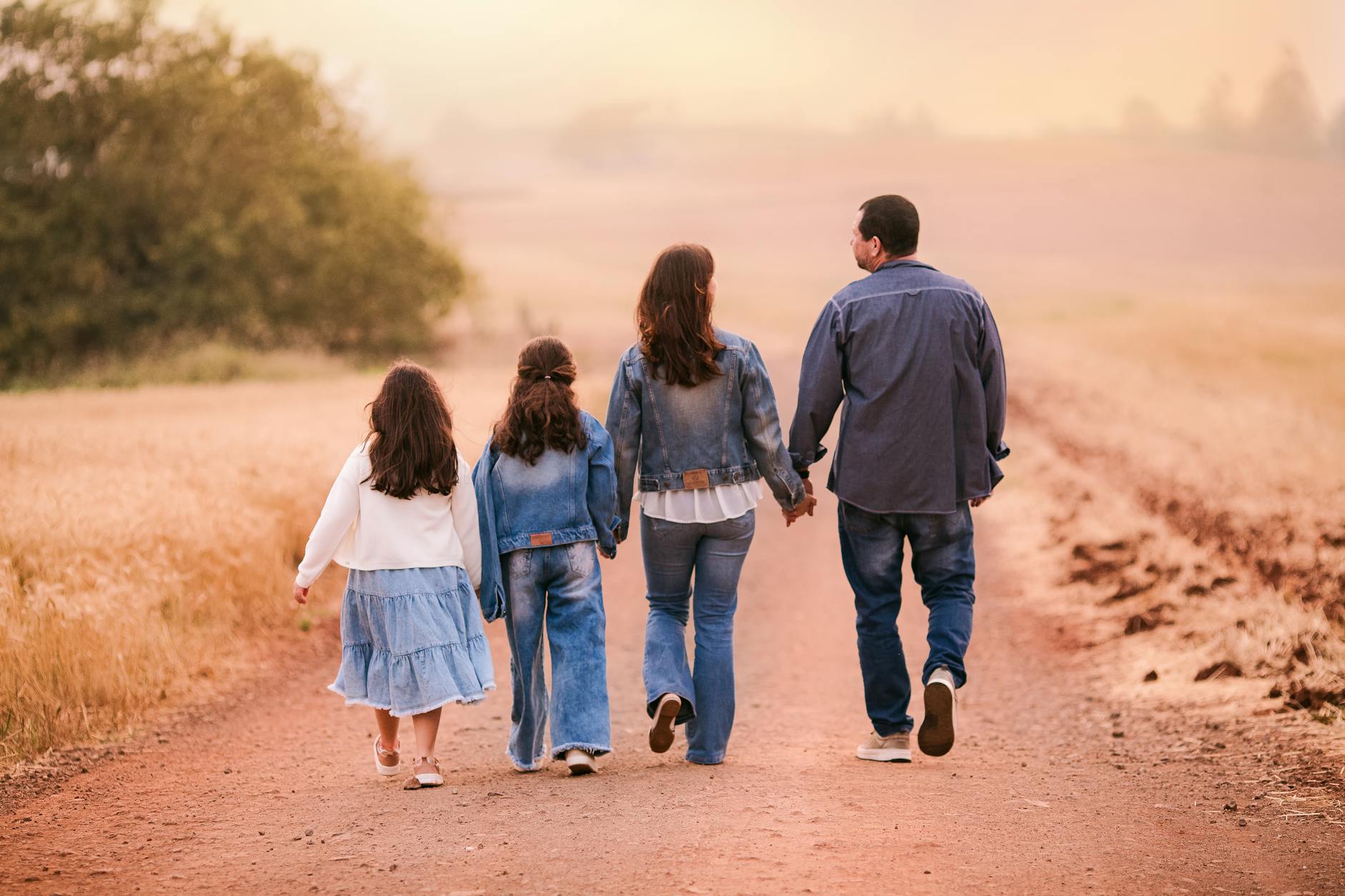
Remember the last time you walked with your kids and they whined “Are we there yet?” for forty straight minutes? You’re not alone – 68% of parents say family walks feel more like hostage negotiations than quality time.
But what if those same walks could become the highlight of everyone’s week?
Family walks don’t need elaborate planning or Pinterest-worthy scavenger hunts to be meaningful. The secret lies in simple mindfulness techniques that transform ordinary family walks into connection opportunities that even screen-obsessed teens enjoy.
I’ve spent years helping families rediscover the joy of walking together, and I’ve noticed something interesting: the families who bond most during walks aren’t doing anything complicated. They’re just doing this one thing differently…
The Magic of Mindful Walking with Family

Why presence matters during family walks
Family walks aren’t just about getting fresh air—they’re golden opportunities for genuine connection. When you’re fully present with your kids, you’re sending a powerful message: “You matter to me right now.”
Kids notice when you’re mentally elsewhere. They see you checking emails or thinking about work deadlines. But they also notice when you’re truly there—asking about that cool rock they found or listening to their story about school.
Present walking creates a special space where conversations flow naturally. Without the pressure of forced face-to-face talks, kids often open up about their worries, dreams, and random thoughts while walking side by side with you.
The benefits go beyond the moment too. Your children are learning how to engage with their surroundings and with people they love. You’re modeling mindfulness without even naming it.
Simple mindfulness exercises for all ages
Try these family-friendly mindfulness activities on your next walk:
- The Five Senses Game: Take turns naming something you can see, hear, smell, feel, and maybe even taste (like wild berries if you know they’re safe!).
- Color Scavenger Hunt: Challenge everyone to spot something in every color of the rainbow.
- Gratitude Steps: With each few steps, share something you’re thankful for, no matter how small.
- Nature Names: Give silly names to trees, rocks, or clouds you pass regularly.
- Walking Like Animals: Take turns walking like different creatures—stretch tall like giraffes or hop like rabbits.
Creating a distraction-free walking experience
Phones are connection killers on family walks. Period. They pull our attention away from both the natural world and our loved ones walking beside us.
Try establishing a “devices away” rule for family walks. If you absolutely must bring your phone (and honestly, for safety reasons, having one is smart), keep it in your pocket on silent mode.
Choose routes that naturally engage everyone. Kids love variety—paths with bridges, tunnels, streams to cross, or hills to climb. Natural obstacles become adventures instead of complaints about tired legs.
Timing matters too. A hungry, tired child won’t be mindfully appreciating anything. Schedule walks when everyone’s fed and rested for the best experience.
Turning Nature into Your Playground

A. Scavenger hunt ideas for different seasons
Who says you need fancy equipment for a great family walk? Seasonal scavenger hunts turn ordinary paths into treasure trails.
Spring hunts: Send kids searching for new buds, bird nests, and puddles perfect for splashing. Challenge them to find five different colored flowers or spot seeds being carried by the wind.
Summer adventures: Look for animal tracks, specific insects, or uniquely shaped leaves. My family’s favorite: finding natural items for each color of the rainbow.
Fall treasures: Collect pinecones, acorns, and leaves in different stages of color change. The best part? Creating art with these finds when you get home.
Winter wonders: Even in the coldest months, hunt for animal footprints in snow, different types of evergreens, or icicles in unique shapes.
B. Nature-inspired games that cost nothing
The outdoors is the original free playground. Try “Meet a Tree” – one person wears a blindfold while another guides them to a tree they must identify by touch alone.
“Nature’s Palette” challenges kids to match colors from a paint sample card to things found in nature. You’d be amazed at how perfectly that sage green matches a certain leaf.
“Sound Maps” transforms listening into a game. Sit quietly for two minutes and draw symbols on paper representing each sound heard and its direction.
“Micro-hikes” shrink adventures to ant-size – use a piece of string to create a tiny trail and explore it with magnifying glasses.
C. Wildlife spotting challenges for curious minds
Kids are natural wildlife detectives. Create a neighborhood field guide together, adding new animals each walk.
For younger explorers, play “Wildlife Bingo” with cards featuring common local creatures. The first to spot five in a row wins small nature-themed prizes like pretty rocks or special sticks.
For older kids, up the ante with species identification apps. My 10-year-old now corrects ME on bird calls after just a few weeks of this game.
Don’t forget the tiny wildlife! Counting different insects or looking under logs for soil creatures fascinates most kids. Just remember the golden rule: look gently, then leave things exactly as you found them.
D. Teaching moments about local ecosystems
Those questions kids ask on walks? They’re perfect learning opportunities. When my daughter asked why some trees still had leaves while others were bare, it sparked a whole conversation about deciduous versus evergreen trees.
Water features like streams or ponds offer instant ecosystem lessons. Count how many different living things you can spot in and around the water.
Create “ecosystem in a jar” collections (just visual items like pine needles, moss, etc.) from different areas of your walk. Compare what thrives in sunny spots versus shady ones.
The best teaching happens when you admit what you don’t know. “I’m not sure what bird that is – let’s look it up together when we get home” shows kids that learning is a lifelong adventure.
Conversation Starters That Strengthen Bonds

A. Age-appropriate questions that go beyond “How was your day?”
Ever notice how “How was your day?” usually gets you a one-word answer? Yeah, not exactly the conversation starter we’re hoping for on family walks.
Try these instead:
- “What made you laugh today?”
- “Who did you help today or who helped you?”
- “If you could change one thing about today, what would it be?”
For younger kids, keep it concrete:
- “What was the yummiest thing you ate today?”
- “Tell me about something new you learned.”
With teens, respect their space while opening doors:
- “What’s something that confused you lately?”
- “Any songs or videos you think I should check out?”
B. Taking turns as family storytellers
Family walks become magical when everyone gets a chance to be the storyteller.
Try the “story stick” method – whoever holds a special found stick gets to tell a story. It might be about their day, a made-up adventure, or a memory.
Another approach? Tag-team tales. One family member starts a story (“Once there was a squirrel who couldn’t find his acorns…”), then passes it to the next person after a few sentences. By the end of your walk, you’ve created something totally unique together.
The best part? You’ll notice your quieter kids often shine when given this space to express themselves.
C. The “what if” game for developing imagination
“What if” questions spark the best conversations and let imaginations run wild.
Some starters that work every time:
- “What if you could design our perfect family vacation?”
- “What if you could talk to animals? Which would you talk to first?”
- “What if we lived in this tree/castle/bridge we’re walking past?”
The beauty of “what if” questions is they have no wrong answers. They invite everyone to dream together, problem-solve creatively, and share perspectives you might never otherwise hear.
Watch how your kids’ answers evolve over time – they reveal so much about their developing values and interests.
Making Walks Memorable with Simple Additions

Photography walks: capturing perspectives
Ever noticed how your kids see the world differently? Hand them a camera (even an old phone will do) and watch the magic unfold. They’ll zoom in on tiny flowers you stepped over and capture angles of familiar places you never considered.
Try giving everyone a theme: “Things that make you happy” or “The color blue.” When you get home, scroll through the collection together. You’ll be amazed at what caught their attention—and what it reveals about how they see the world.
My neighbor’s 6-year-old took the most incredible photo of a puddle reflecting clouds. It’s now framed in their hallway—a masterpiece that would’ve been missed without their pint-sized perspective.
Sketch breaks: drawing what catches your eye
No artistic talent required! Pack a small sketchbook and some pencils, then pick a spot that feels right. Give everyone 10 minutes to draw whatever interests them.
Kids naturally draw what actually matters to them, not what “should” matter. Their squiggly interpretation of that “boring” rock formation might show you exactly what you’ve been missing.
The real beauty? These sketches become time capsules. My friend’s family has a drawer full of nature sketches dating back years—complete with misspelled labels and stick-figure family members that get taller with each passing season.
Collecting treasures: from pinecones to memories
Turn your walk into a treasure hunt without spending a dime. Bring a small bag and collect nature’s gifts: interesting pebbles, fallen leaves, or oddly-shaped sticks.
When you get home, create a simple display or craft with your findings. We’ve seen families create seasonal tables, nature mandalas, or even just a special “treasure jar” that holds memories from each outing.
One dad I know photographs his daughter holding her “treasure of the day” in the same spot on every walk. The growing collection shows not just the changing seasons, but her growth too—same smile, increasingly bigger hands.
Geocaching adventures for tech-loving families
Think of geocaching as a worldwide treasure hunt hiding in plain sight. Download the app, and suddenly your regular walking route transforms into an adventure map with hidden containers waiting to be found.
Kids who drag their feet on “boring walks” suddenly become enthusiastic explorers when there’s a mission involved. The containers usually contain trinkets to trade and a logbook to sign—physical proof you were there.
What makes it special? You’re joining a secret community of adventurers. Finding that cleverly hidden container gives kids a genuine “aha!” moment that no video game can match.
Picnic surprises to elevate ordinary outings
Forget elaborate setups. Even a shared snack on a fallen log can feel magical if it’s unexpected. Pack something small but special—hot chocolate in a thermos, cookies wrapped in foil, or fruit sliced into funny shapes.
The real trick? Don’t announce it. Wait until someone says they’re tired or hungry, then casually mention, “Good thing I packed us a little something.”
My sister keeps a “walking picnic kit” ready to grab—just a small blanket and container of bite-sized treats. Her kids now associate family walks with those surprise moments when everything stops and they simply enjoy being together.
Building Traditions Around Regular Routes

Creating seasonal milestones on familiar paths
Walking the same route doesn’t have to be boring—it can become the backdrop for magical family traditions. Choose a special spot along your regular walk that you’ll visit during each season. Maybe it’s that grand oak tree or the bridge over the stream.
Take photos there in spring when wildflowers bloom, summer when the leaves create a perfect canopy, fall when everything turns golden, and winter when frost covers the ground. Kids love seeing how one place transforms throughout the year.
Mark these seasonal visits with tiny rituals. In autumn, collect the most colorful leaves. In winter, measure the snow depth. In spring, count the new buds. These simple activities become anticipated moments your kids will ask about: “When are we doing our tree visit again?”
The “same spot, different day” photo series
Parents everywhere discover this trick eventually: photographing your kids in the same exact spot as time passes is pure magic. Find a bench, rock, or landmark that doesn’t change and snap a photo each time you visit.
The power comes when you compile these images months or years later. That little one who once needed help climbing up now leaps onto the spot effortlessly. Their height against that fence post tells a story words never could.
Make it fun by letting kids choose their pose or creating a silly tradition—thumbs up, jumping shots, or serious faces that inevitably dissolve into giggles.
Celebrating walk milestones with special rewards
Kids thrive on recognition, so why not celebrate your walking achievements? Track your family walks (there are apps for this or just use a colorful chart at home) and set milestone rewards.
After 10 walks on your favorite trail, maybe it’s hot chocolate at that café you normally just pass by. Hit 25 walks? Time for a new walking stick or special backpack.
The real genius is celebrating moments that might otherwise go unnoticed. “This is our 50th time walking this path together!” suddenly turns an ordinary Tuesday afternoon into something memorable.
Some families even create badges or certificates for walk achievements—crossing a certain distance, spotting wildlife, or completing walks in all kinds of weather. Your kids will beam with pride at becoming “Certified All-Weather Walkers” or earning their “Dawn Patrol” badge for early morning adventures.

The simple act of walking together as a family holds transformative power. By practicing mindfulness during these outings, embracing nature’s playground, and engaging in meaningful conversations, you create opportunities for genuine connection. Adding simple elements like scavenger hunts or picnic stops can elevate ordinary walks into cherished experiences, while establishing regular routes builds traditions that children will remember for years to come.
Take that first step today—literally. Choose a nearby trail, neighborhood loop, or park path and make it your family’s special place. The memories you create on these walks will become the stories your children tell their own families someday. The most meaningful traditions don’t require elaborate planning or expense—just your presence, attention, and the willingness to see the extraordinary in an ordinary family walk.

